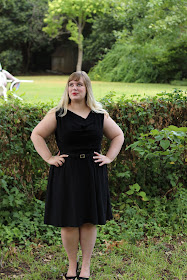Bonsoir, kittens! Tonight, we're chatting about my latest pattern love: the Colette Myrtle. Why yes, this pattern was released over a year ago. While I would like to blame a packed schedule or full wardrobe for this creative delay, that would be a lie.
Here's the truth, y'all: I have a pathological fear of cowl necks.
They're elegant on most women, but potentially disastrous for large busts. Whenever I try on ready-to-wear cowls, they twist and pull like the devil. Even if the garment itself is oversized, the bust inevitably drags. When the Myrtle debuted, I shrugged it off as a pretty pattern that didn't suit my body type. Cut to a year later and the lovely Lilli, of Frocks & Frou Frou. Lilli's latest version of the Myrtle, a gorgeous nebula-print dress, convinced me this pattern could work on curves. Hell, it could look downright fabulous on curves! Each of Lilli's Myrtles is exactly the chic, easy-to-wear type of dress I love.
Quickly, this Myrtle lust became all-consuming. Within three days, I had printed the PDF, taped it all together, and sewn two new dresses. Considering how absent my sewing motivation has been, that is a rare thing, indeed.
The first version of the dress, pictured below, was made in black cotton-viscose jersey from Mood Fabrics. My wardrobe is in desperate need of solids, at the moment. I've recently finished a massive closet purge and everything left is a floral, a stripe, or a novelty print. A replacement little black dress was just the thing! With Myrtle's beautiful drape and sophisticated silhouette, it's the sort of pattern that's easily dressed up with the right fabric and accessories. This medium-weight jersey made a Myrtle that's ideal for a cocktail party or night out. (More photos can be found at the Mood Sewing Network blog.)
Solids are also better for test runs of knit patterns. Prints can easily hide fitting mishaps, after all. This black Myrtle was a size XL, with a small full bust adjustment and additional hem length. As you can see in the pictures, the fit is almost right. It's a darling little dress, but there is some pulling along the bust line. It's the curse of the cowl neck! Despite being well within the measurements for the XL and doing an initial adjustment, I still needed more front bodice width.
Otherwise, I loved this dress. It was quick to make--about two hours, after cutting--and really straight forward to put together. The front bodice is cleverly self-lined, with a doubled pattern piece folded along the cowl line. Everything but the back bodice finishes and skirt hem can be sewn on a serger, which streamlines the construction process.
One technical note: I did change the method of elastic insertion. The pattern tells you to sew the top of the casing first, then stretch and pin the elastic around the waist, before finally stretching and sewing the casing bottom down. While this prevents the beginning seamstress from running elastic through a casing, it was untenable for me. My waist is smaller than the intended measurements, so my elastic was impossible to pin and stretch properly. After one failed attempt, I opted for a more traditional method. I sewed the casing down completely, leaving a three-inch opening at the side seam. Using a safety pin, I threaded the elastic through, then sewed the casing shut.
 |
| Fun fact! It was super windy, while shooting these, The hem is, in fact, straight. |
For my second Myrtle, I chose an orange and white poppy-print jersey, also from Mood. This fabric is a favorite of my fellow MSN bloggers, used recently in Lauren's gorgeous wrap dress and Lori's chic sheath. It's easy to understand the love, after sewing with it. This viscose knit is lightweight, but still completely opaque, and has amazing stretch and recovery. I adore how cool rayon knits are against the skin, while still draping beautifully. They're quickly becoming my go-to knits, for summer garments.
Myrtle II also benefitted from further fitting adjustments. I added width to the bodice front, with a bigger FBA, which allows the cowl to drape lower and eliminated the bust pulling. Otherwise, this dress was constructed identically to my first. Every seam is serged, the finishings were twin-stitched, and the hem is interfaced with light fusible webbing.
This is the cowl-neck dress of my dreams. The bodice falls beautifully over my curves and the skirt swishes, with each step. I usually don't love elastic waist dresses, but the wide casing of this one really works for my figure. I like it both with and without a belt! You can expect more of this pattern, in the near future, as it blends perfectly with my lifestyle right now. Knit pieces that dress up easily are exactly what I reach for, each morning. They're as comfortable as yoga pants, but more socially acceptable!
That, my dears, is a win. Well done, Myrtle.
Note: The fabric for these dresses was given to me, as part of my participation in the Mood Sewing Network. However, I chose both lengths myself and all opinions are my own.












